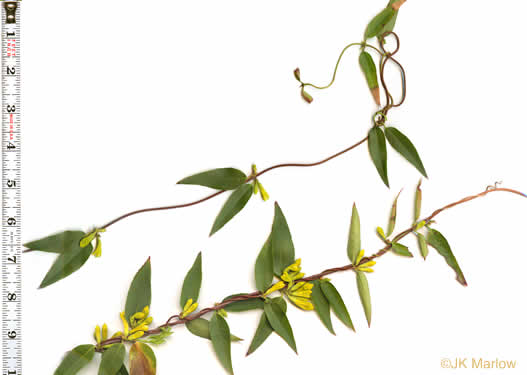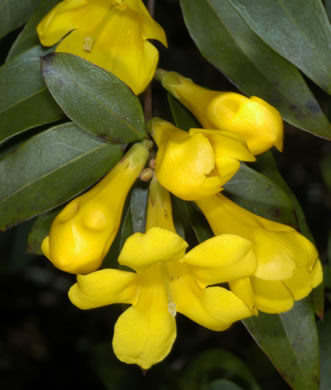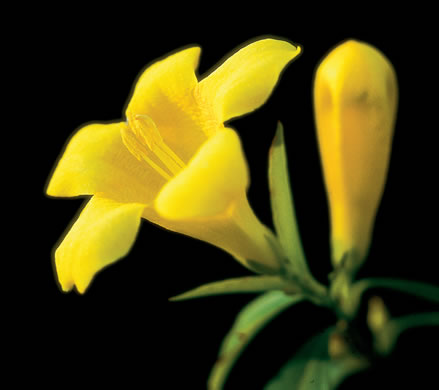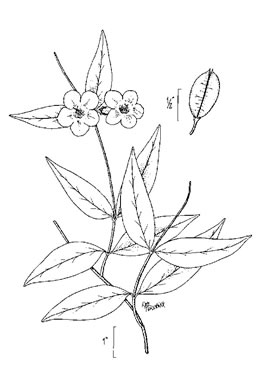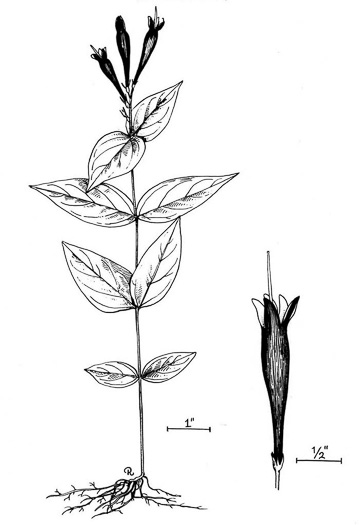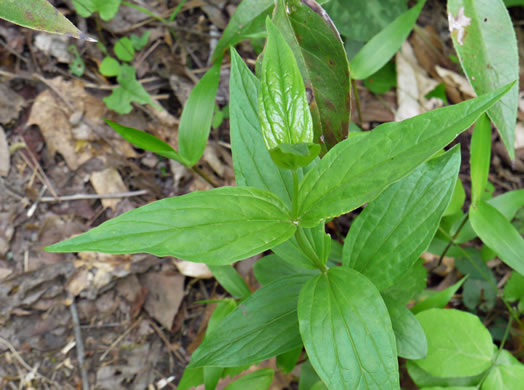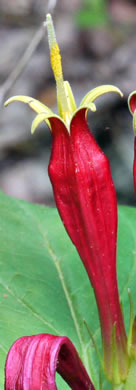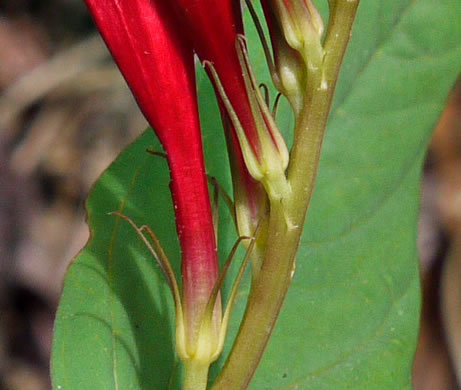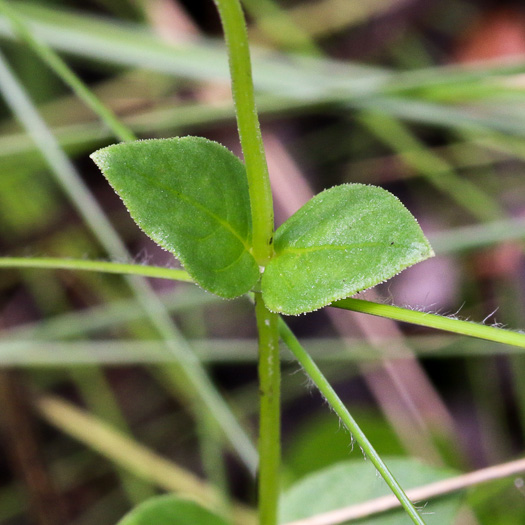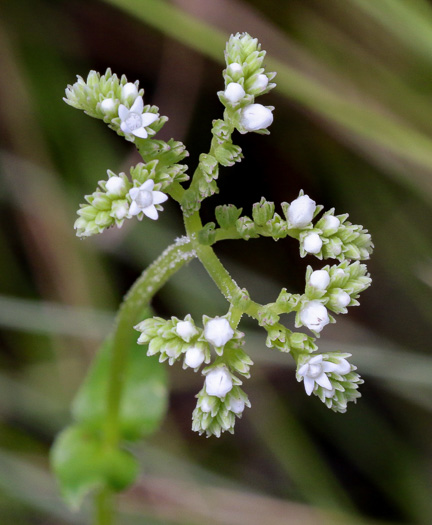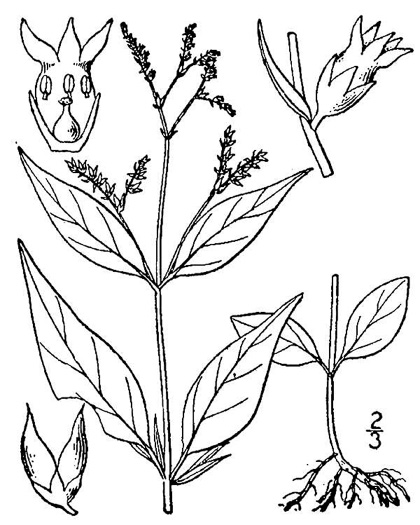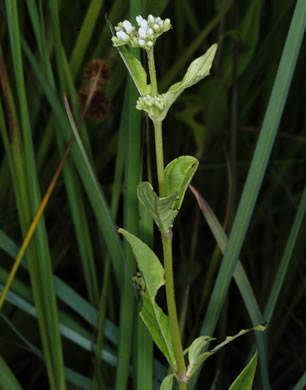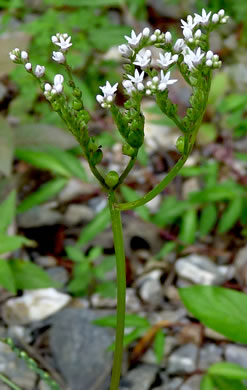Hovering over an image will enlarge it and point out features (works better on desktop than on mobile).
![]() A camera indicates there are pictures.
A camera indicates there are pictures.
![]() A speaker indicates that a botanical name is pronounced.
A speaker indicates that a botanical name is pronounced.
![]() A plus sign after a Latin name indicates that the species is further divided into varieties or subspecies.
A plus sign after a Latin name indicates that the species is further divided into varieties or subspecies.
Most habitat and range descriptions were obtained from Weakley's Flora.
Your search found 6 taxa in the family Loganiaceae, Logania family, as understood by PLANTS National Database.

![]()
![]() Common Name:
Carolina Jessamine, Yellow Jessamine
Common Name:
Carolina Jessamine, Yellow Jessamine
Weakley's Flora: (4/24/22) Gelsemium sempervirens FAMILY: Gelsemiaceae
SYNONYMOUS WITH PLANTS National Database: Gelsemium sempervirens FAMILY: Loganiaceae
SYNONYMOUS WITH Vascular Flora of the Carolinas (Radford, Ahles, & Bell, 1968): Gelsemium sempervirens 154-01-001 FAMILY: Loganiaceae
Habitat: In a wide range of habitats, from swamp forests to dry uplands and thickets, also commonly planted as an ornamental
Common (uncommon in Mountains of GA & SC) (rare in Mountains of NC)
Native to the Carolinas & Georgia

![]() Common Name:
Swamp Jessamine
Common Name:
Swamp Jessamine
Weakley's Flora: (4/24/22) Gelsemium rankinii FAMILY: Gelsemiaceae
SYNONYMOUS WITH PLANTS National Database: Gelsemium rankinii FAMILY: Loganiaceae
SYNONYMOUS WITH Vascular Flora of the Carolinas (Radford, Ahles, & Bell, 1968): Gelsemium rankinii 154-01-002 FAMILY: Loganiaceae
Habitat: Blackwater river swamps, Atlantic white cedar swamps along streams
Common in GA Coastal Plain (uncommon in Carolinas)
Native to the Carolinas & Georgia

![]()
![]() Common Name:
Indian-pink, Woodland Pinkroot, Wormgrass
Common Name:
Indian-pink, Woodland Pinkroot, Wormgrass
Weakley's Flora: (4/24/22) Spigelia marilandica FAMILY: Loganiaceae
SYNONYMOUS WITH PLANTS National Database: Spigelia marilandica FAMILY: Loganiaceae
SYNONYMOUS WITH Vascular Flora of the Carolinas (Radford, Ahles, & Bell, 1968): Spigelia marilandica 154-02-001 FAMILY: Loganiaceae
Habitat: Moist to dry woodlands and forests, usually on circumneutral soils
Common (rare in NC)
Native to the Carolinas & Georgia

![]() Common Name:
Small-leaved Miterwort, Swamp Hornpod
Common Name:
Small-leaved Miterwort, Swamp Hornpod
Weakley's Flora: (4/14/23) Mitreola sessilifolia FAMILY: Loganiaceae
INCLUDED WITHIN PLANTS National Database: Mitreola sessilifolia FAMILY: Loganiaceae
SYNONYMOUS WITH Vascular Flora of the Carolinas (Radford, Ahles, & Bell, 1968): Cynoctonum sessilifolium 154-03-001 FAMILY: Loganiaceae
Habitat: Wet pine savannas, pocosins, ditches, margins of limesink depressions (dolines)
Common in Coastal Plain (rare in Piedmont)
Native to the Carolinas & Georgia

Common Name: Narrow-leaved Miterwort
Weakley's Flora: (4/14/23) Mitreola angustifolia FAMILY: Loganiaceae
INCLUDED WITHIN PLANTS National Database: Mitreola sessilifolia FAMILY: Loganiaceae
Habitat: Clay-based Carolina bays, other Coastal Plain depressional wetlands
Rare
Native to South Carolina & Georgia

![]() Common Name:
Caribbean Miterwort, Lax Hornpod
Common Name:
Caribbean Miterwort, Lax Hornpod
Weakley's Flora: (4/14/23) Mitreola petiolata FAMILY: Loganiaceae
SYNONYMOUS WITH PLANTS National Database: Mitreola petiolata FAMILY: Loganiaceae
SYNONYMOUS WITH Vascular Flora of the Carolinas (Radford, Ahles, & Bell, 1968): Cynoctonum mitreola 154-03-002 FAMILY: Loganiaceae
Habitat: Swamps, marshes, ditches, seepage areas on calcareous glades, other wet habitats
Common in GA Coastal Plain, uncommon in Carolina Coastal Plain (rare elsewhere in GA-NC-SC)
Native to the Carolinas & Georgia
Your search found 6 taxa. You are on page PAGE 1 out of 1 pages.


